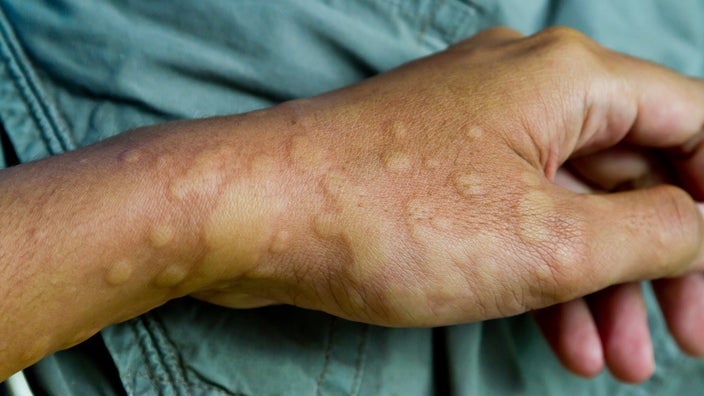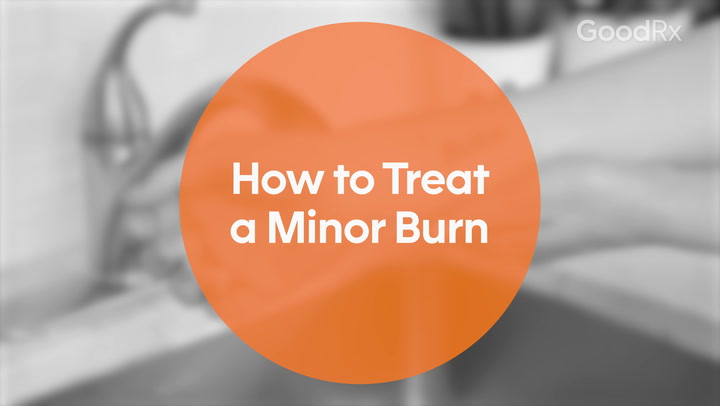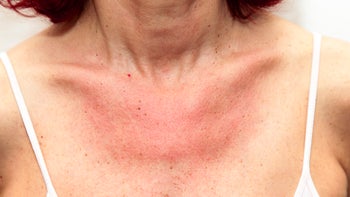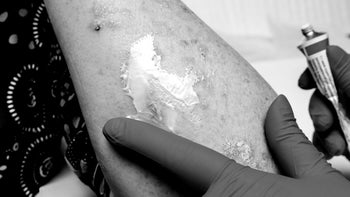
What Causes Chronic Hives?
Key takeaways:
Chronic hives are transient, itchy rashes that can occur on any part of the body, and continue to return for longer than 6 weeks.
There are many different causes for chronic hives, but usually the cause is never found.
Chronic hives can take anywhere from 1 to 5 years to resolve. But there are some medications that can alleviate the symptoms until they go away.

Most people are familiar with urticaria — commonly referred to as “hives” — a type of itchy rash that often occurs alongside an allergic reaction. Allergic hives generally occur quickly and consistently after a known trigger, like a food or medication. But in about 1 in 20 people, hives become a long-term (chronic) condition and can keep coming back over and over again for long periods of time. This can be a distressing experience, especially when symptoms are unpredictable and you don’t know where they are coming from. Read on to learn more about chronic hives, their possible causes, and treatment options.
What are chronic hives?
Chronic hives are a type of itchy skin rash that keep coming and going. There are many different kinds of itchy skin rashes, like eczema and contact dermatitis. But hives are unique in a few key ways:
Hives are smooth bumps. They aren’t scaly, crusty, or rough.
Hives go away without leaving a mark — they don’t leave behind any skin color changes, scabbing, bruising, or flaking.
Hives can come on and go away quickly. Typically a patch of hives disappears within 24 hours.
Search and compare options
In fact, hives can resolve in as little as 30 minutes, but new hives may continue to appear on other parts of the body. “Chronic hives” are those that keep coming back for 6 weeks or longer.
Causes of chronic hives
Hives occur when the body releases histamine, a type of chemical the immune system makes. Allergic hives tend to have a clear trigger that leads to histamine release. But chronic hives often don’t have a clear cause. In one large review of nearly 6,500 people with chronic hives, fewer than 2% were able to find a cause for their symptoms. But let’s review some frequently suspected triggers.
Could a food allergy cause chronic hives?
Hives from a food allergy should be consistent and predictable. With a food allergy, there will be a reaction every time you eat the food, even just a small bite. The reaction also happens quickly, often within a few minutes to an hour of eating the food. If you avoid the food, you shouldn’t get any hives.
Unfortunately, chronic hives generally don’t follow this pattern. Food allergies are unlikely to cause chronic hives. And testing for food allergies isn’t generally recommended in people with chronic hives.
Can other health conditions cause hives?
Some people may wonder if chronic hives are a sign of another serious health problem, like cancer. Fortunately, people with chronic hives are not more likely to have cancer or develop cancer in the future. But chronic hives do seem to be associated with certain health conditions, possibly related to increased inflammation. But these conditions will often cause other symptoms besides just chronic hives:
Autoimmune disorders: People with chronic hives are more likely to have autoimmune disorders. The strongest link seems to be with autoimmune thyroid disorders, including both hyperthyroidism and hypothyroidism.
Infections: Chronic hives have also been linked to different infections like hepatitis B, hepatitis C, herpes, and Helicobacter pylori (a common, long-term bacterial infection of the stomach that can cause stomach ulcers).
Read more like this
Explore these related articles, suggested for readers like you.
Can stress cause chronic hives?
Very often, people with chronic hives notice their hives are worse with increased stress. There are studies that support this observation, though this might be a “chicken-and-egg” phenomenon. After all, chronic hives can be very uncomfortable, interfere with sleep, and cause significant stress on their own. More research on the link between chronic hives and stress is still needed.
Other factors to consider
Even if chronic hives don’t have a clear cause, some exposures can make them worse or cause them to flare more often:
Physical triggers: Heat and cold, or even scratching, can sometimes lead to hives. These are known as “physical hives” (or physical urticaria). The most common type of physical hives are due to scratching, known as “dermatographia.”
Medications: Certain medications, especially NSAIDs like ibuprofen or aspirin, can lead to increased symptoms for some people with chronic hives.
Alcohol: Alcohol can also cause chronic hives to flare. Around 5% to 10% of people with chronic hives find that alcohol worsens their symptoms.
Treatment options for chronic hives
If your hives are mild or infrequent, you might not need treatment. But treatment could be helpful if your hives are severe, frequent, or get in the way of your everyday life. Over-the-counter antihistamines are the medication of choice for chronic hives. Some common options include:
Diphenhydramine (Benadryl) and other older antihistamines can be effective for flares, but they can also make you sleepy.
Zyrtec (cetirizine) or Allegra (fexofenadine) are examples of newer antihistamines that you can use daily to prevent hives. These are much less likely to make you sleepy, and they last around 24 hours.
Famotidine (Pepcid AC) is often used for stomach problems, but it’s also a type of antihistamine that can help control hives.
For hives that don’t get better with antihistamines, there are prescription treatment options. Some examples are:
Singulair (montelukast) is an oral medication that’s often used for allergies and asthma but can also be helpful for hives.
Prednisone or methylprednisolone (Medrol) are oral steroid medications. These can provide quick relief for several weeks but aren’t for long-term treatment.
Xolair (omalizumab) is a monthly injected medication that can help treat very severe or stubborn hives.
How long do chronic hives last?
It’s difficult to predict how long chronic hives will last, but symptoms generally last around 2 to 5 years for most people. About 1 out of 3 people don’t have symptoms after the first year, and about 2 out of 3 people don’t have symptoms after 5 years. People who have autoimmune issues or physical triggers for their hives may be more likely to have symptoms for longer than 5 years.
The bottom line
Chronic hives are a common condition that can cause both stress and discomfort. But they’re rarely a sign of other health issues. For most people, they’re a very bothersome but otherwise harmless condition. It’s certainly reasonable to see a healthcare provider to discuss your symptoms and any triggers you may suspect. Together, you can figure out a plan to ease your symptoms until they eventually resolve on their own.
Why trust our experts?


References
Adams, K. E., et al. (2013). Adverse reactions to alcohol and alcoholic beverages. Annals of Allergy, Asthma & Immunology.
American Contact Dermatitis Society. (n.d.). Contact dermatitis FAQ.
American Family Physician. (2017). Hives.
American Osteopathic College of Dermatology. (n.d.). Dermatographism.
Ben-Shoshan, M., et al. (2013). Psychosocial factors and chronic spontaneous urticaria: A systematic review. Allergy.
Bernstein, J. A., et al. (2014). The diagnosis and management of acute and chronic urticaria: 2014 update. Journal of Allergy and Clinical Immunology.
Confino-Cohen, R., et al. (2012). Chronic urticaria and autoimmunity: Associations found in a large population study. Journal of Allergy and Clinical Immunology.
Hiragun, M., et al. (2013). Prognosis of chronic spontaneous urticaria in 117 patients not controlled by a standard dose of antihistamine. Allergy.
Kozel, M. M. A., et al. (2003). Laboratory tests and identified diagnoses in patients with physical and chronic urticaria and angioedema: A systematic review. Journal of the American Academy of Dermatology.
Lindelöf, B., et al. (1990). Chronic urticaria and cancer: An epidemiological study of 1155 patients. British Journal of Dermatology.
Malhotra, S. K., et al. (2008). Role of stressful life events in induction or exacerbation of psoriasis and chronic urticaria. Indian Journal of Dermatology, Venereology and Leprology.
Namazy, J. A., et al. (2002). Sensitivity to non-steroidal anti-inflammatory drugs. Annals of Allergy, Asthma & Immunology.
National Organization for Rare Disorders. (n.d.). Urticaria, physical.
The Editors of the Encyclopedia Britannica. (2020). Histamine.
Toubi, E., et al. (2004). Clinical and laboratory parameters in predicting chronic urticaria duration: A prospective study of 139 patients. Allergy.
Vakil, N. (2021). Helicobacter pylori infection. Merck Manual Professional Version.





























